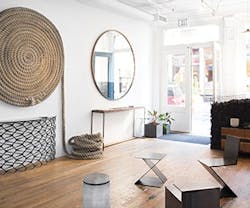The Uhuru showroom in the fashion-forward Tribeca neighborhood of New York City opened in May 2015 as an extension of the furniture producer’s workshop in Red Hook, Brooklyn. The new location is easier to get to for Manhattan-based designers, and showcases the possibilities of the well-crafted brand. The expanse of the first floor of the space includes a wide selection of Uhuru pieces that are suitable for residential use but can be customized for commercial specification. “We usually like to start upstairs, whether the designer is [working in] residential or commercial, just to give them a sense of our company’s history and where the inspiration behind all of the designs comes from,” noted Madeleine Hines, an Uhuru account manager who oversees the showroom.
The large slab table (below) is a focal point upon walking into the showroom, and is often utilized by designers to meet with the Uhuru team and discuss projects. “We’re known for doing the live-edge dining table with one of our bases,” Hines noted. “We’ve recently done a lot of conference tables that are this style with solid wood, so you get a residential feel in the workplace. This is a good example of our work.”
The entrance area of the showroom pays homage to both Red Hook’s shipping industry roots, in addition to the previous tenant of the space. Before Uhuru moved into its Tribeca home, the location served as the studio for artist Donald Sultan. Well-known for his pop art pieces, the company decided to honor Sultan by keeping the original wood floors, which have noticeable paint splatters from the days when art was created there.
A cozy private room at the back of the main floor is inviting with a fireplace and stocked bar. Social gatherings like happy hours for design groups are hosted in this area, along with meetings that have a more relaxed feel. “We want to invite people in so they’ll talk to us and learn more about Uhuru,” Hines said. “A lot of what we do is custom so it is not as straightforward as seeing a line of chairs in a row [in the showroom]. They have to take an opportunity to see what we are capable of. So many of the pieces have stories behind them.” For example, the chairs in this room are made of reclaimed oak from bourbon barrel staves; the base comes from New York City firetruck leaf springs.
All of the lighting in Uhuru’s Manhattan location is by Los Angeles-based designer Brendan Ravenhill as the space serves as his permanent New York showroom. “When people come in they often ask about the lighting,” Hines noted. “We try to promote him.”
While Uhuru started in the high-end residential market, it has become more popular in commercial applications over the last three to five years, Hines said. The offerings for these spaces are inspired by the original residential pieces, but made with materials that will stand up to wear and tear of a high traffic environment. Commercial products are created by the same Uhuru team, but are manufactured in either its Pennsylvania workshop or overseas in Vietnam where larger quantities are produced. “We have commercial designers come in here to get a sense of our design and craftsmanship. A lot of our pieces can be adapted for commercial spaces.”
“Uhuru has always been so narrative in our designs,” said Sean McKusick, account manager. “I think the showroom definitely feels the same. When you see things like the Cyclone lounge chair, you see everything has a story.” The Cyclone Lounger, right, is made of Ipe wood
salvaged from the demolished Coney Island boardwalk, which was first constructed in the 1940s. “The design, you can see, captures the Cyclone roller coaster,” Hines added.
Products made for commercial use are kept on the lower level of the showroom. Uhuru’s new workplace system, which debuted at NeoCon, conveys the same vibe as its other creations, and is made with the same materials to help carry the characteristics of the brand. “The profile on [the table] leg is the same leg profile that you’ll see on the huge slab table when you walk in,” McKusick said. “You wouldn’t think, ‘Here’s a 20-foot-long slab table, maybe I can make a desk system out of that.’ But using that as a front point of inspiration, it came to be what you’re looking at here. We produce these at much larger quantities, at a price point that is completely different than what you’re seeing upstairs.”
Photography courtesy of Uhuru Design
